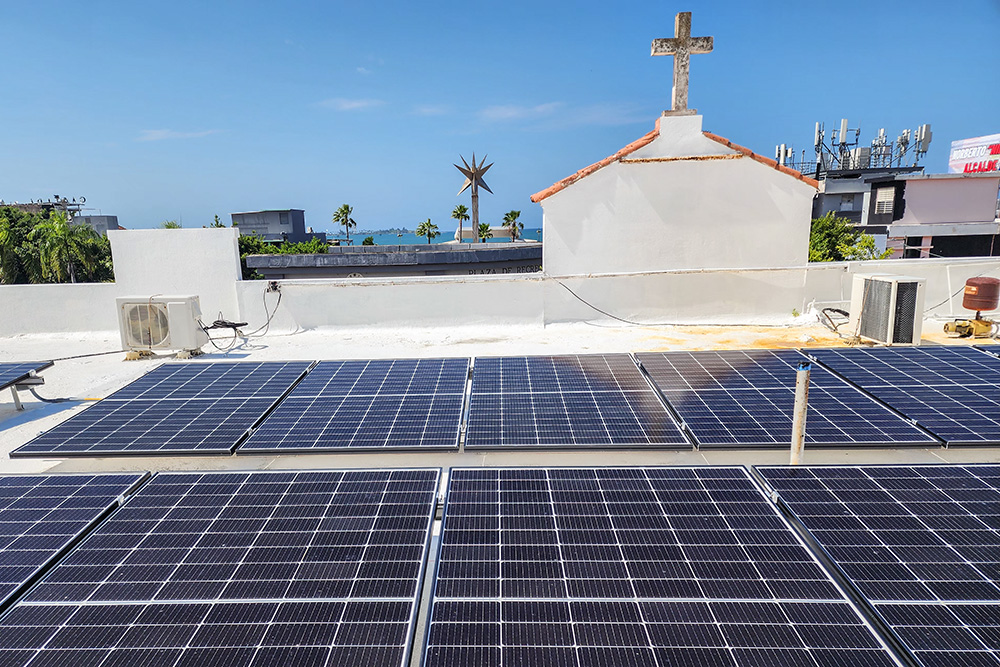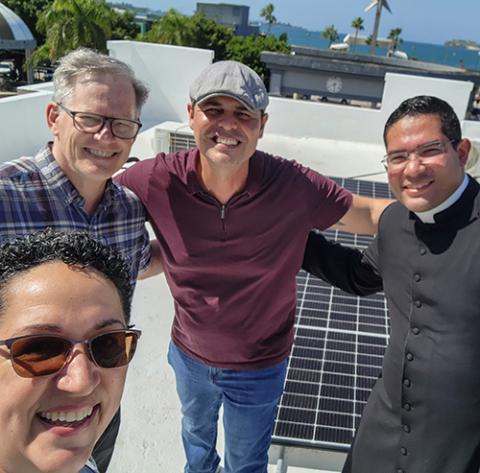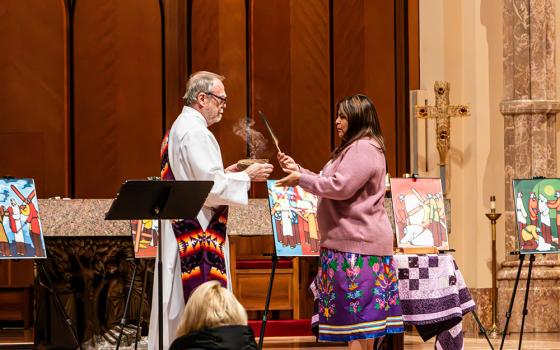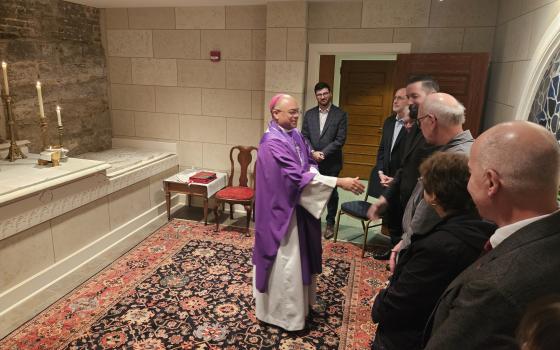
A new rooftop solar array at Nuestra Señora del Carmen in Cataño, a town bordering the San Juan Bay in Puerto Rico, will serve as a source of community resilience in the face of future climate disasters. (Courtesy of Lissette A. Avilés-Ríos)
Nuestra Señora del Carmen Parish in Cataño, a town bordering the San Juan Bay in Puerto Rico, installed solar in March to prepare for the threat of coming storms and serve as a centerpiece for a climate resilience hub.
Dominican Sr. Lissette Avilés-Ríos, a member of the Parish Pastoral Council, explained that the parish wants to help the community organize and respond in future disasters. Cataño's coastal location makes it vulnerable to the effects of climate change, such as hurricanes like María in 2017. Rather than rely on the electric grid in Puerto Rico, which is unstable and frequently experiences power outages, the church opted for the independence offered by solar — a move supported by many Catholics.
In 2017, the one-two punch of Hurricane Irma and Hurricane María left 100% of the island without electricity, limited access to food and clean water, and caused 4,600 deaths. When María hit, Avilés-Ríos chose to stay in her convent on Calle Ocean Drive, right in front of the bay, in order to help neighbors who were older or living alone.

From left: Dominican Sr. Lissette Avilés-Ríos, Stewart Hudson from the Leon Lowenstein Foundation, David Ortiz of Solar United Neighbors, and parish priest Fr. José Gabriel Corazón launched the rooftop solar system at Nuestra Señora del Carmen Parish in Cataño, Puerto Rico. (Courtesy of Lissette A. Avilés-Ríos)
"The level of the bay rose with the storm surge and reached the convent hall," she said. "The second floor flooded when water entered through the balcony doors."
Eventually the power went out that September and didn't come back until November. "Thank God we did not have major damage to the structure; it is made of cement," she added.
David Ortiz, the Puerto Rico director of Solar United Neighbors (SUN), said the experience of Hurricane María and Hurricane Irma left lessons to apply in becoming more resilient for future storms.
Since then, Archbishop Roberto González Nieves has encouraged all 142 parishes to switch to solar by 2030 in a pastoral letter on implementing the teachings of Pope Francis' 2015 encyclical Laudato Si' in the Archdiocese of San Juan de Puerto Rico.
For SUN, that letter signaled the commitment they wanted to see before awarding funds earmarked for frontline communities to create resilience hubs in Puerto Rico. Both Nuestra Señora del Carmen and Centro Buen Pastor, a Catholic nonprofit eco-spirituality center in Guaynabo, received enough funds to cover the cost of equipment and installation.
What is a resilience hub?
The term "resilience hub," coined by the Urban Sustainability Network, includes coordinating community networks of care that provide a safety net in case of an emergency. A resilience hub often begins with identifying a stable source of renewable energy.
Ortiz said this is because access to electricity affects communication — if people can't charge their phones or connect to Wi-Fi, they can't contact their loved ones. It also impacts vulnerable community members, such as those needing medical devices or refrigeration for medicine, or a simple fan to keep an infant cool on a hot day. Clean water fails, too, because pumps need electricity to run.
Avilés-Ríos explained that the church wants to amplify the impact of its solar to be available to the community. "This gives us the security of being able to provide help for those people, parishioners or not, who can charge their cellphones, refrigerate medications or receive respiratory therapies," she said.
To Ortiz, it's a logical choice to provide solar to entities like churches that have proven they are poised to leverage resources to disadvantaged community members. During past hurricane response, "the churches and community groups in many cases were the first ones there to help, because government still couldn't get there or couldn't reach that mountain, but outreach organizations, community organizations, and churches were able to throw stuff on their back and make it up the hill," he said.
Understanding the energy system
Resilience hubs need durability and stability amid an emergency situation to keep power running to meet neighborhood needs.
Ortiz said the solar panels installed at Nuestra Señora del Carmen are made to sustain winds for a Category 3 hurricane. "They tend to hold on," he said.
Advertisement
The panels in the church's system each have micro-inverters, which take direct energy from the sun and turn it into electricity. This means the whole system will keep running even if one panel blows down. In contrast, if damage occurs on a system with a central inverter for all the panels, the power may go down for the whole system.
Either way, getting a panel back up isn't too complex. Ortiz remembers how those with solar fared after María. "I saw it firsthand in my neighborhood," he said. One neighbor's panels stayed intact, and the other had two fly off, but both had electricity.
Additionally, if the grid is down, the local internet company might go down as well. Since most systems rely on a Wi-Fi connection to keep users informed about the amount of storage left on their battery, Ortiz recommends satellite internet.
Another key is having enough storage, said Ortiz. Most solar systems in Puerto Rico are connected to the public electrical grid via net metering, which feeds surplus solar energy back to the grid in exchange for customer credit. But U.S. electric code requires the panels to shut down when there is a power outage to protect workers who are trying to restore the lines in the electric grid. With an inverter, the panels can send electricity to your battery instead.

The new rooftop solar array at Nuestra Señora del Carmen in Cataño, Puerto Rico (Courtesy of Lissette A. Avilés-Ríos)
Nuestra Señora del Carmen already knows that its system works. The system stayed up and running during a recent six-hour power outage.
But the key is still knowing how much storage you will need or how to conserve energy when you're relying only on your solar system. "Sometimes people overconsume when they know a hurricane is coming," said Ortiz. "They wash all these clothes ... and only have half a battery left."
Plus, cloudy days — which are likely during a storm — will generate less electricity. So, a resilience hub might want to decide ahead of time what usage to prioritize, said Ortiz.
Building a community plan
Avilés-Ríos, who is appointed by the bishop to advise on ecological pastoral matters, said the community is in the meeting phase of deciding what resources the resilience hub can offer and how it will operate.
"We still lack details of the plan, but there is a lot of enthusiasm in the community," she said. "We must establish a protocol for when there is a lack of electricity in Cataño."
The hub plans to identify other families in the parish who have solar and create a community map, so everything is not dependent on the church. It will also decide how they might offer other resources beyond electricity, such as food and water.
Avilés-Ríos sees the parish in Cataño as a model for others. "We will guide and motivate the parish communities of the entire archdiocese to establish their ecological action plan," she said.
Of course, while two parishes received full funding through grants, other parishes have not yet accessed funds for solar. Ortiz and Avilés-Ríos said opportunities for federal funding, such as Inflation Reduction Act tax credits, are more limited for churches in Puerto Rico. Unlike churches in the states, the parishes in Puerto Rico cannot directly receive the tax credit.
"We know that there are funds allocated," she said, but "the structure does not make it easy for us to access those funds."
Once the panels and installation are paid for, Ortiz said, net metering could help pay for other aspects of a resilience hub. However, there's been a hiccup. Nuestra Señora del Carmen is still waiting for the meter to be switched to net metering, so that it can earn energy credits. If it saves money on electricity, the church could invest it back into the resilience hub.
Ortiz further pointed out that officials in Puerto Rico have made moves to remove net metering despite its recent extension of the policy. As more electric customers go solar, utility companies worry about lost revenue.
"Although there are economic challenges to establishing photovoltaic systems with backup batteries, we cannot lose hope of achieving it," said Avilés-Ríos. "It is not a merely economic matter but a Christian matter to make good use of the resources of creation and to be a place of help for everyone who needs it."







